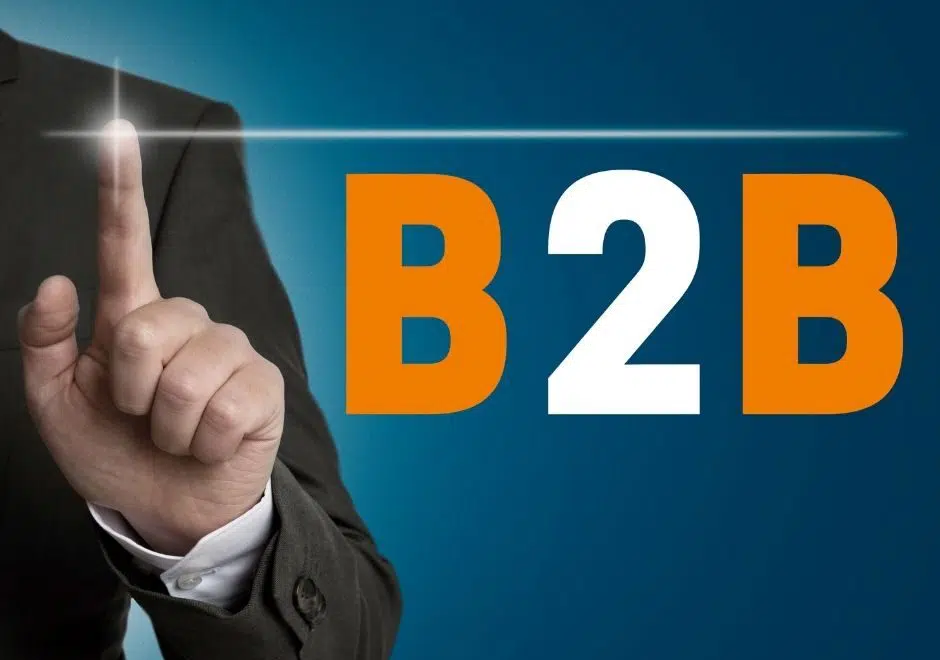Due to the rapid advancement of technology and intent-based data, buyers no longer require salespeople to make product and service recommendations. It is changing the face of business development and you need a robust B2B sales strategy in 2022 if you are going to make an impact and grow your business.
Today, buyers are aware of their requirements and thoroughly explore available solutions online.
It means that you can no longer convince prospective clients that your goods are the greatest on the market; you must demonstrate it to them. You must go to them rather than expecting them to come to you.
The most effective approach to accomplish this and win their business is to to have highly effective B2B sales strategy for your team to execute.
In this article we will define B2B sales, discuss the barriers to customer acquisition in the B2B market, and offer tactics for acquiring new business clients and successfully moving them through your sales funnel.
What are B2B Sales?
Business to business is abbreviated as B2B. B2B sales refer to a commercial transaction in which a company sells a product or service to another business rather than a person.
When things are sold directly to consumers, the marketing is referred to as B2C, or business-to-consumer.
B2B sales can take on a variety of shapes. A factory, for instance, could sell heavy construction equipment to a real estate development company or mining company. Alternatively, companies might acquire software licences from another company that developed it. Accounting firms can assist other businesses with tax preparation and bookkeeping.
Whatever shape B2B sales take, they all have certain traits. They typically involve more expensive and complex items, longer sales cycles, many stakeholders in the purchasing decision, and a smaller potential consumer base than B2C.
What are the Most Recent B2B Sales Obstacles?
The environment of B2B sales is continuously changing. Today’s salesmen and women encounter a different set of challenges than they did in the past. Here are some of the roadblocks your business will meet and how you can overcome them with a quality B2B sales strategy.
Modern purchasers are more suspicious.
We live in an age when marketing messages and sales pitches are constantly bombarding us. Businesses will make any promises — some of which may not be genuine — to entice us to buy from them.
As a result, purchasers are increasingly wary of advertising and prefer to conduct exhaustive research before entrusting a brand with their business.
To combat this and improve clients’ perceptions of your brand, reduce overt, aggressive marketing and instead focus on assisting them in resolving their difficulties.
When buyers realise that you’re genuinely committed to giving them valuable information that enhances their business performance, they’re more likely to trust your business and investigate anything you’re selling.
Buyers in the modern era rely on reviews and feedback.
When you go to purchase the latest laptop or smartphone, you will generally do a lot of research and check reviews before making a purchase, especially if it’s via an online marketplace.
It’s the same for B2B buyers too. Before they make a purchase, they’re going to research your product/service extensively online. If your reviews and testimonials do not paint a favourable picture, they will choose one of your competitors with higher ratings.
Ascertain that you’re creating social proof to boost people’s trust in your business and increase sales. Create case studies, solicit reviews and testimonials from existing clients, and publish them on your website.
Modern purchasers are more cognisant of the hazards associated with a purchase.
For B2B purchasers, a poor purchase can negatively affect their business operations, and there isn’t always money in the budget for a redo. This is why they take their time weighing the possibilities and mitigating potential hazards to avoid regretting their choice later.
How a B2B Sales Strategy Can Increase Customer Acquisition Rates
Generating B2B leads and converting them to sales is not a skill that can be acquired overnight. However, by consistently implementing efficient methods such as those listed below throughout your sales process, you’ll improve your ability to convert your funnel into a revenue-generating machine.
Adopt a sales enablement mindset.
Research is a vital phase in the B2B buyer’s journey. You want to ensure that your organisation provides them with the information they require to make an informed decision.
According to a 2020 Edelman survey, 49% of decision-makers believe thought leadership material influences their purchasing decisions, and 89% believe it has enhanced their impressions of an organisation.
The content you create should be compelling and helpful to those reading. Consider including long-form articles, white papers, reports or case studies with detailed information on how your solution can assist buyers at each stage in their journey.
Conduct market research and conduct surveys of your existing customers to ascertain how your product adds value to them and where they are experiencing challenges, and then produce content around those insights.
Distribute and promote your material and ensure that it is optimised for search engines so that potential purchasers can easily find and benefit from it. This manner, when the time comes for consumers to select a vendor or service provider, they’ll think more favourably of your brand.
Empower your sales representatives.
Over 28% of firms claim that employee advocacy helps them expand their message’s reach without social media marketing. Additionally, purchasers regard peers or colleagues as the most trustworthy source of information when making purchasing decisions.
This means that brand material created by your team members is more likely to be well-received, trusted, and engaging than content created by your business.
Leverage this by presenting your salespeople as thought leaders in their respective niches. Assist them in setting up and optimising their social media profiles, and encourage them to share pertinent information that your target audience will find helpful.
Allow them to demonstrate how your firm has assisted others in resolving their pain points and provide concrete suggestions to assist prospects in navigating their circumstance. This is how you pique buyers’ interest without eliciting distrust.
Acquaint yourself with your prospects thoroughly.
The key to increasing customer acquisition is lead generation. However, how are such leads qualified?
It begins with research to learn as much as possible about your prospects to build a pitch or marketing message that will resonate with them.
What difficulties are they currently confronted with? How is their purchasing procedure typically conducted? Who are the business’s decision-makers? Where is the most convenient location for you to contact them?
These insights will assist you in becoming more acquainted with your prospects. And the more information you have about them, the more adept you will be at tailoring your marketing plan to their specific needs and positioning your product or service as a solution to their problems.
Align the sales and marketing teams around the same objective.
By failing to align your marketing and sales teams, your organisation is likely to miss out on significant income opportunities. To achieve the best outcomes, bring both groups together and empower them to work collaboratively to address your clients’ demands throughout the buying journey.
Encourage your marketing team to routinely produce content assets and share them with the sales team. Allow them to train salespeople on how and when to use assets for lead nurturing. Both teams should have regular shutdowns to ensure that their efforts are coordinated.
Your email marketing team should collaborate with your social media team to ensure that they share relevant items in the appropriate sequence and target the appropriate personas across channels.
A significant impediment to sales and marketing divisions aligning is a lack of shared and reliable data on target clients and campaigns. Utilising project management software can assist you in resolving this issue and maintaining track of critical facts that benefit both parties.
Within two years, SuperOffice improved business income for its Dutch office by 34% by unifying the sales and marketing teams. By implementing this strategy, you can improve your results even further.
Create buyer personas for your ideal customers.
Who are the target recipients of your products or services? Which industry do they work in? How much revenue do they generate? Where are they to be found? What are their motivations and qualms? How many employees do they have?
When answering these questions, do not rely solely on your intuition. Consider your current customer base and the characteristics they share.
Examine your social media profiles to discover more about the individuals following and connecting with your page. Conduct research to amass accurate data about your target market. Utilise the data gleaned from these and other sources to develop your client profiles.
By spending time developing buyer profiles, you can prevent your sales staff from wasting resources on unqualified leads that will never convert.
Be foresightful.
Your B2B sales strategy should prioritise building trust through long-term relationships, bringing value to your buyer’s life/work/business, and assisting them in achieving their goals.
Yes, it would be desirable to close the deal quickly, and it is acceptable to employ strategies that reduce the sales cycle. However, you must exercise caution in your approach. Buyers do not wish to be rushed or coerced into deciding before they are ready.
Therefore, if you are excessively active in promoting your sales plan, you will irritate the buyer and force them to reconsider patronising you.
Maintain your focus on the goal—customer acquisition. Strive to provide an exceptional customer experience from beginning to end. This will have a significant impact on the buyer’s final decision.
Promote solutions rather than items
Consider your organisation to be a solutions provider that also sells the product or service you’re offering. Keep in mind that what matters most is what your product can do for the buyer.
Therefore, rather than extolling the virtues of all its unique features, emphasise its benefits to the buyer. Diagnose the issues their business is facing and the requirements they have and explain how your product or service will assist them in resolving those issues and satisfying their needs.
Utilise email marketing to establish meaningful relationships, maintain contact with prospects and customers, and educate them about the solution you offer and why it is superior to competitors’ offers.
This sales tactic works because it immediately makes your prospect feel understood, listened to, and valued. By tailoring a solution to their problem, you can build trust and boost your chances of closing the purchase.
Utilise social media to cultivate leads
Research shows that 45% of internet users utilise social media to conduct product or service research so it is an essential component of your B2B sales strategy.
When your consumers go to social media to begin their purchasing journey, they should come across you connecting with your network.
Meet and create relationships with your target audience on LinkedIn, Twitter, and other social media sites where they congregate.
Social selling is about engaging and nurturing prospects by posting content they’ll find valuable and relevant and promptly responding to their inquiries. According to current statistics, 90% of consumers consider a rapid response—10 minutes or less—to be highly critical when they have a customer care query.
Initiate discussions regarding issues of mutual interest. Inquire about them to learn more about them. Provide advice to assist them in resolving any concerns they may have.
While many people use social media as part of their daily routine, clients are not constantly online and engaged at all hours of the day, so determining the optimal time to engage with them can help guide your marketing plan.
Finally, don’t forget to observe your social media KPIs so you can determine what works and how your efforts contribute to the company’s overall goals.
If you are looking for social media content ideas or want to plan your social media strategy for 2022 then the we have some great articles on the topic – click the links in this paragraph or view our latest articles.
Maintain contact with cold leads.
The majority of prospects and leads you deal with are unlikely to make a purchase immediately or soon. However, this does not mean they will never purchase from you.
You only need to keep them warm until they’re ready to act by periodically sending follow-up emails to remind them of the value your products may add to their business and ascertain their position.
If you’re one of the 18% of salespeople who have never heard of a CRM platform or one of the 27% of marketers who have not invested in one, it’s time to alter that – it is a core tool needed to execute any B2B sales strategy.
Customer relationship management is a critical component of the B2B marketing and sales process. You cannot afford to make errors or use inaccurate data that could jeopardise the connection.
This is where a customer relationship management (CRM) product comes in handy. It enables you to store prospect and customer data, track service issues, identify sales possibilities, and manage campaigns, among other functions.
With complete visibility into every customer interaction, you can consistently nail your targeting, lead nurturing, and customer experience.
Create a successful business-to-business sales procedure
Acquiring business-to-business customers is a skill.
It demands you to identify qualified prospects and nurture them with the appropriate message, delivered via the suitable means, in the proper time.
Utilise the methods listed above to assist in development a B2B sales strategy for your business. When prepared and executed well, you will successfully grow your business and create long-lasting connections with your business customers.
Having a quality and efficient content strategy is an important part of any B2B sales strategy. Chatter Digital provides a range of social media content and article writing services to help you do this efficiently, cost effectively, and most importantly, to a high standard.







